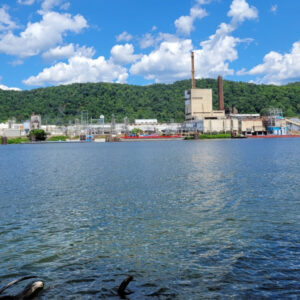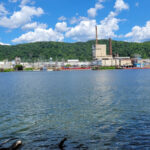- Share on Facebook
- Like
- Digg
- Tumblr
- VKontakte
- Buffer
- Love This
- Odnoklassniki
- Meneame
- Blogger
- Amazon
- Yahoo Mail
- Gmail
- AOL
- Newsvine
- HackerNews
- Evernote
- MySpace
- Mail.ru
- Viadeo
- Line
- Comments
- SMS
- Viber
- Telegram
- Subscribe
- Skype
- Facebook Messenger
- Kakao
- LiveJournal
- Yammer
- Edgar
- Fintel
- Mix
- Instapaper
- Copy Link
- Bluesky
By Heather Sprouse, Ohio Rivers Coordinator at West Virginia Rivers Coalition
 The Ohio River has been designated as the second most endangered river in the country. Each year, American Rivers, a national nonprofit, releases a report of our nation’s most endangered rivers, naming those that stand before decisions that will determine their fate. The Ohio River stands before such a moment of great decision.
The Ohio River has been designated as the second most endangered river in the country. Each year, American Rivers, a national nonprofit, releases a report of our nation’s most endangered rivers, naming those that stand before decisions that will determine their fate. The Ohio River stands before such a moment of great decision.
West Virginia Rivers worked to partner with organizations that share our values to amplify the need for urgent action: Three Rivers Waterkeeper, Ohio River Valley Institute and Ohio Environmental Council. We see an opportunity to use this designation as a springboard for the urgent action we need to protect human and ecosystem health.
The upper Ohio River watershed in Pennsylvania, Ohio, West Virginia and eastern Kentucky drains from areas affected by environmental pollution due to a legacy of heavy industrialization. This legacy includes coal mining, fracked gas development, chemical production, and durable goods manufacturing. These forms of industrialization have resulted in significant discharges of toxic chemicals, including both legacy chemicals (such as mercury and dioxins) and chemicals of emerging concern (especially PFAS and Gen-X chemicals) as well as acid mine drainage. The best science shows us that these toxic pollutants have harmful, serious health impacts both to humans and ecosystems.
We believe that the people facing the worst impacts of pollution and climate change know the solutions that they need to thrive. Impacted communities have identified common priorities: a just transition to a low-carbon economy with abundant good paying family-supporting jobs, a clean and healthy environment, access to nature-based recreation on our waters and in our public lands, ecosystem restoration and affordable access to safe drinking water.
Each year the federal government invests hundreds of millions of dollars to restore our nation’s great waters, including the Chesapeake Bay and the Great Lakes. Currently, the Ohio River is not on the list of waters that receive this funding. In 2020 alone, the Great Lakes received more than $300 million dollars in federal restoration funds. This type of annual investment is needed to achieve goals in the Ohio River watershed that will prevent shared problems from getting worse and more expensive to fix.
The Ohio River Basin Alliance (ORBA) has been working to develop an Ohio River Restoration Plan modeled after restoration successes in the Great Lakes. To inform the priorities of this plan, ORBA has partnered with the National Wildlife Federation (NWF), of whom WV Rivers is the state affiliate. NWF has led listening sessions, virtually and in person, with community groups throughout the vast watershed- from New York to Alabama and onto the Mississippi River. In West Virginian, we have co-hosted 6 listening sessions: 2 virtually and 4 in-person (Wheeling, Parkersburg, Huntington and Williamson).
ORBA intends to deliver a robust Ohio River Restoration Plan to Congress later this summer. The first draft is nearly complete. We are compiling the listening session data into a report that will be used to refine the priorities of the Restoration Plan.
The Ohio River watershed is vast- it covers more than 200,000 square miles across 14 states and provides the primary source of drinking water for more than five million people. In addition to its cultural and historic importance, the river provides critical habitat for 150 species of fish and the watershed protects endangered species such as the candy and diamond darter, several species of mussels, and crayfish. The Ohio River is a vital, abundant resource for our communities and economies and yet, without federal investment, remains vulnerable.
The recent chemical release resulting from the Norfolk Southern train derailment in East Palestine, Ohio is a loud warning. The derailment resulted in harmful air pollution and hazardous butyl acrylate leaked into the Ohio River. The Ohio River Valley Water Sanitation Commission (ORSANCO) led immediate monitoring efforts of the chemical plume as it made its way downriver, informing decisions by water utilities of how to respond. ORSANCO urgently needs additional federal funds to upgrade technical systems and increase staff capacity.
Congress must act to protect human and ecosystem health by increasing funding for ORSANCO and adding the Ohio River to the list of our nation’s great waters that receive significant, sustained funding each year. These actions will provide communities with the resources they need to clean up and prevent pollution, increase tourism and small business development through nature-based recreation, rehabilitate ecosystems and safeguard clean, healthy drinking water for the millions who drink from the waters of the Ohio River watershed.
Join the online Ohio Rivers listening session on May 24.
Support Restoration Investments!





